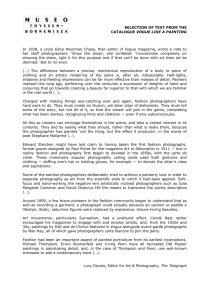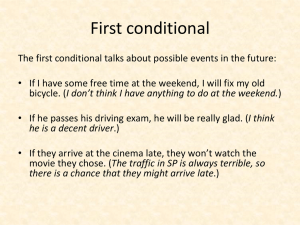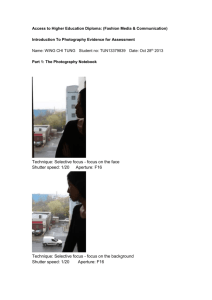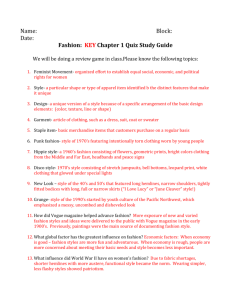Vogue: A Reflection of American Times - Essay Analysis
advertisement
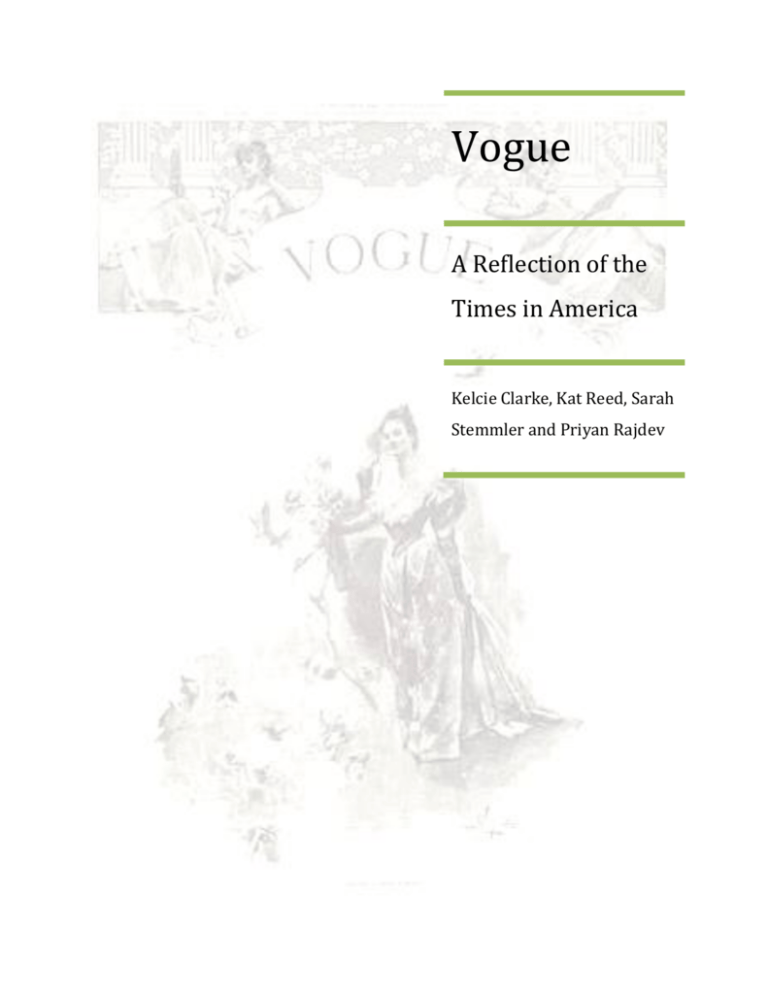
Vogue A Reflection of the Times in America Kelcie Clarke, Kat Reed, Sarah Stemmler and Priyan Rajdev 1 VOGUE: A Reflection of the Times in America The emergence of Vogue magazine led to the inspiration of fashion and culture to flourish within American society. Vogue was able to take advantage of the social, economic and cultural factors present in American society during the 1890’s and perpetuate consumerism and luxury for the modern women’s lifestyle. Strategically, Vogue became the leader of society’s accepted norms and pushed boundaries to allow its vision to be seen by the masses and then accepted as the status quo. From the beginning Vogue was able to capture the spirit of the times that it was created in, and continued to evolve to fit within each time period that it became part of, and maintained its influence. From the birth of Vogue, through its redefinition in 1909, and beyond, the publication has had a significant influence on the American nation as it determined the classifications and the standards of fashion, culture and society, and continues to do so to this day. Vogue emerged in a historical time period where the social, economic and cultural environment provided the perfect setting to cultivate and nurture the birth of the magazine. When Vogue initially appeared in 1892, America was flourishing. Due to the high socio-economic status of the elite class it seemed as though luxury was a lifestyle that some had and everybody strived to possess. Wealth was displayed in fashion through the rising popularity of haute couture. Europe gave birth to hand crafted wear for the elite, and America soon followed suit when it began to domestically produce its own version of haute couture.1 However, due to the high costs only the upper-class could obtain these handcrafted, and often imported, items. To accommodate the growing need to possess and demonstrate wealth, department stores developed in America to allow for individuals to indulge in extravagance2, without the cost associated with hand-sewn garments. This led to the rise in consumerism.2 As more individuals entered the working class, a new social strata was born. The middle class appeared and sought to gain access to the extravagance that had been reserved solely for the elite in the past. 3 The emergence of this new class allowed for the “democratization of fashion”, allowing economic factors such as 1 English, B. (2013). A cultural history of fashion in the 20th and 21st centuries: From catwalk to sidewalk. (2nd ed.). New York, NY: Bloomsbury Academic, 9 2 English, B. 14 3 English, B. 17 2 production systems, mass manufacturing, incentive advertising and marketing techniques to improve dramatically4. Mass manufacturing and production were possible as materials became cheaper, which allowed items to become more accessible to producers and subsequently consumers.5 As Vogue switched hands in 1909 and its identity was reconstructed, America was soon after thrust into the First World War in 1914. Conspicuous consumption and the luxurious way of life were placed on the backburner as American society was completely focused on the war efforts. With the resolution of the First World War, a booming social-economic status emerged within America. Two income families had become a reality during the war period, which resulted in households now possessing discretionary income, a luxury never before experienced by anyone below the elite class.3 This new era of extra Figure 1: Photographer Unknown: Arthur Turnure, 1906 Source: Vogue.com spending money and extra time for leisure activities were huge catalysts for society’s evolution into the 1920’s. The culture in the 1920’s encouraged the coercion of women into the need for unattainable goods.3 Wealth combined with the culture of consumerism and allowed America to whole heartedly embrace, fashion, culture and art. In 1892, Arthur Baldwin Turnure founded and created Vogue magazine for New York City’s social elite.6 In the first issue of the magazine, published on December 17, 1892, Turnure stated that “the definite object is the establishment of a dignified, authentic journal of society, fashion, and the ceremonial side of life…”7 It was obvious that Turnure had a clear vision for the magazine; to monitor the alluring excitement of the elite class of New York City. Vogue was unlike any other magazines of its time for many reasons, particularly because it targeted both men and women, and did not solely focus on the home and sewing.7 It covered the news of the local social scene, traditions of high society, and social etiquette; it also reviewed books, plays, and music.6 Vogue was, in the early years, a slim weekly gazette that chronicled 4 English, B. 11 English, B. 12-13 6 Encyclopedia Brittanica: Vogue. (2013). Retrieved from http://www.britannica.com/EBchecked/topic/631831/Vogue 7 Vogue: Arthur Baldwin Turnure. (2013). Retrieved from http://www.vogue.com/voguepedia/Arthur_Baldwin_Turnure 5 3 everything of interest to the Social Register set: weddings, debuts, parties, engagements, and club meetings.7 It added a transparency to the aristocratic class, and determined what would be “fashionable” within American society. Vogue was intended for only the aristocrats of New York, but eventually the popularity of the publication and the growing middle class called for the magazine to be redesigned to fit a wider audience. In 1909, Condé Montrose Nast, the founder of Condé Nast Publications, bought Vogue and reconstructed its identity.6 Nast transformed the publication into a women’s fashion magazine focused on beauty, composure, and etiquette.6 This revolutionized the magazine, and although it effectively eliminated the audience of male readers, it allowed for a wider target audience to be pursued outside of the elite. However, when the magazine was revolutionized to Figure 2: Photographer Unknown, Condé Montrose Nast Source: Vogue.com target women the price did raise to a higher price point.8 Women of every social status could gain access to the publication; it was now a medium that dictated appropriate luxury to the masses. Under the leadership of Nast, Vogue took its visuals in innovative directions and soon became known for its distinctive photographs and high editorial quality.6 This movement elevated Vogue into a class of its own, as it was completely differentiated from its competitors within the market. Nast hired the best illustrators and photographers of the day, and they produced covers for the magazine that were consistently sophisticated and ground-breaking.6 He pushed the boundaries of societal norms to make the magazine distinctive in the eyes of its audience. For example, in 1932 Vogue became one of the first magazines to print a colour photo on its cover, moving away from the initial illustrated drawings that originally ordained the front of the magazine.6 And in the 1960s, the magazine redefined the look of female models, eschewing shapely figures to highlight thin, gender-neutral physiques.6 Vogue’s new identity pushed boundaries and secured the magazines mission in becoming the leader in defining fashion, culture and society. 8 Conde nast russia: Vogue. (2010). Retrieved from http://condenast.ru/en/portfolio/magazines/vogue/history/ 4 Fashion was, and always will be a reflection of the times in which we live. Vogue, as a driving force in the fashion industry can attest to that. It is said that the cover of Vogue will tell you all you need to know about a given time period; it will convey not only current trends and styles, but can even go so far as to reflect the current economic state of a country. From fluctuating hemlines to flapper dresses, and everything that followed, Vogue played an irreplaceable role in not only showcasing fashion, but also influencing it. Before the turn of the century “the beautiful body had rotund breasts, a handspan waist, accentuated hips and a protruding posterior. The S-bend corset convoluted the spine”.9 The launch of Vogue would change the way fashion was perceived and experienced in that era, and many more to come. In a time where the fashion industry was in its infancy and Paris dictated fashion, it was unbeknownst to its readers at the time, but Vogue would soon change the face of fashion forever. In stark contrast with the times in which the magazine was founded, the January 1910 issue of Vogue featured ‘The Motor Girl’ on its cover, after an interview with Charles Frederick Worth on the possibility of women wearing trousers. Inside, the articles would debate and rationalize the decline of the horse as a means of transport, and the rise of cycling, skiing and motoring, as a progression. Another notable change in direction took place in September 1916 when Vogue switched its emphasis from reporting and discussing, to predicting and defining. In April 1917 Vogue predicted the most important looks of the decade; Figure 3: Vogue January 1910 Cover "The Motor Girl" Source: Condenast.com the change from the cloche hat to the Russian turban. An excerpt of the article would read, “Next, trousers: ‘If womankind once gets over the stile and into the pantaloons, will she care to climb back and into the prosaic skirt?”10 In later years, after paying Chanel considerable compliments in the November 1927 issue, Vogue declared the death of uniformity and the rise of art and luxury in conjunction with the rise of cinema as this would ushered in a new era of fashion. In November of 1959, Vogue’s cover was a reflection of the times. It showcased partygoers, teenagers and personal style, its 9 Watson, L. (2008). Vogue Fashion, Over 100 Years Of Style By Decade And Designer, In Association With Vogue. (1 ed., Vol. 1). Buffalo: Firefly Books Ltd. Print. Page 18. 10 Watson, L. 28. 5 caption, “What does fashion represent? Decoration? Disguise? A mood of society?” 11 This would prompt readers to delve into their personal motivations for self-expression through fashion. Other notable shifts and breaking fashion norms perpetuated by Vogue include encouraging innovation in the magazine’s 1966 issue which supported the rise of futurist Paco Rabanne, and ‘Le Smoking’ jacket by Yves Saint Laurent. 12 As fashion is a reflection of the times in which we live, Vogue not only acts as a vehicle for style and influence, but a catalyst. “Even [Charles Frederick] Worth, as early as 1912, alluded in an interview his concern that American designers might develop a viable fashion industry of their own that would compete with Europeans.”13 This concern became a reality when Vogue was purchased by Conde Nast in 1909, and the director was persuaded into taking advantage of the changing market. Edna Woolman Chase, once said “the women of American high society could be coerced into buying from the top New York [fashion] houses.”13 This statement encompasses Vogue as a predetermined vehicle of influence. From its conception, Vogue has shifted from reporting and discussing to predicting and defining. Trends do not rise in popularity and then trickle-up to Vogue. It is the contrary- Vogue dictates the trends, which then trickle-down to the masses. The influence of Vogue on the maturation of America reached far beyond the scope of fashion, to penetrate through the roots of society. With Vogue’s redefinition in 1909 it became a publication targeting female readers, however the effect that the magazine had on society was felt by all individuals, including men and children. Women’s lives were defined by Vogue in obvious ways, such as through their wardrobe, but the magazine Figure 4: Vogue Cove Source: Vogue.com also affected societal norms such as driving a consumerism culture, the visible exemplification of status, the definition of beauty, and acceptable body types. These societal norms were altered if not completely manifested by Vogue at one time or another and the female audience took the mentalities preached in their favourite publication into their households and to their families. Vogue showcased elite status parties, 11 Watson, L. 87 Watson, L. 99 13 English, B. 67 12 6 garments, and accessories that were once unattainable for the masses, and created a need exhibited by lower-class women who wanted to take part in that lifestyle. The fantasy of obtaining a piece of luxury in their life moved into the realm of the possible with the end of World War One and the realization of wealth that had accumulated in households. With the need for ‘more’ previously instilled in these Vogue women, they led their households into the new spending patterns of a post-war, consumerism driven America. With the acquisition of the post-war purchases came the need to display them. Figure 5: Vogue Cover Source: Vogue.com This is not a new concept, however Vogue “demonstrated to the country that even during the most difficult times, elite women were still concerned for their fashion and beauty as they always have been.”14 As decades passed by, the ideal form of beauty evolved, and Vogue has always been at the forefront, promoting each new movement. At the publications birth, the ‘Victorian Woman’ was on its way out of the spot light, and the world moved into the Edwardian Period, embracing a thinner, more boyish figure. As you peruse through the Vogue archives, the magazine’s promotions of the ‘new’ definitions of beauty are visible across the varying covers. On the April 1910 cover, a soft, feminine woman is depicted organizing her collection of favourite hats. There is noticeably no eye contact with the reader. As we move to August 1930, the ideal beauty has now evolved into a thinner, casual woman, who has been depicted draped across a sofa. She still lacks Figure 6: Vogue Cover Source: Vogue.com eye contact, but has become more self-assured and confident with her sexuality, as exemplified through her pose and dress. By November 1939 the ideal beauty is bold and unafraid, as three women glare into the photographer’s lens. Red lips and the illusion of no clothing further support this ‘new woman’ who is extremely aware of the allure of her sexuality. 15 The changing ideals of beauty have been consistently reflected throughout the pages of Vogue in every decade. ‘Whether it be the liberated elite of the 1920’s, the idealized housewives of the 1950’s, the workingwomen of the 1970’s, or today’s unpredictable indefinable woman, Vogue’s archives tell 14 Taub, Laura. Vogue’s Influence on Women in the Twentieth Century (2012). Retrieved from http://ltaubj150.blogspot.ca/2012/02/vogues-influence-on-women-in-twentieth.html 15 From the Archives: Vogue Looks Back at 120 Years of Covers. Vogue Daily. (2011) Retrieved from http://www.vogue.com/vogue-daily/article/from-the-archives-vogue-looks-back-at-120-years-of-covers/#/gallery/vogue-covers/3 7 the story of women’s changing role in society, and subsequently the standard of beauty that they are held to.’14 Vogue is “the evolution not only of fashion but of women themselves, how they choose and wear clothes, interpret beauty, assume a changing role in society.”16 American dress was highly influenced by what Hollywood was projecting on the big screen. “Of all the visual arts film-making – more than anything else – often acted as a catalyst to determine the direction in which fashion was headed.”17 Movies were able to transform a pedestrian lifestyle into artwork. Film stars were famous for their style; Greta Garbo for her cloche hat, Charlie Chaplin for his bowler hat, and Marilyn Monroe for her bleach blonde hair, provocative neckline and Figure 7: Photographer Unknown Source: Vogue.com flowing silhouettes. In the 1910 silent films were dependent on exaggerated appearances as dress was a fundamental role in the development of a plot. By the 1930s “film designers in Hollywood produced clothes that rivaled those of the French couturiers in quality, expense and glamour, and which had an enormous influence on the public”18 It seemed like a natural progression to hire couture designers to produce garment for film, however this occurred without great success. Elsa Schiaparelli designed and created the costume for Mae West’s 1937 film Every Day’s a Holiday, however when they arrived on set it was discovered that the Parisian based styles were far to small to fit. Another example is Coco Chanel’s work in 1939 La Regle de Jeu to create function sportswear. The audience was disappointed at the lack of extravagance they expected to see in theatres. Givenchy was a success story for his work on 1957’s Funny Face and 1961’s Breakfast at Tiffany’s. Funny Face ‘marked a transitional move from haute couture to prêt-a-porter, seemingly anticipating the new ideal.” 16 19 Givenchy dressed Audrey Hepburn as she transformed from a Figure 8: Photographer Unknown Source: Theskinnystiletto.com Smith, Emily Esfahani. The Early Years of Vogue Magazine. Acculturated. (2013). Retrieved from http://acculturated.com/2012/06/26/the-early-years-of-vogue-magazine/ 17 English, B. 72 18 English, B. 73 8 shop girl to “haute couture princess.”20 Givenchy’s work on Breakfast at Tiffany’s ‘had an immediate and profound influence on both 1960s couture style and popular women’s fashion.”21 Audrey Hepburn’s costumes were recognized as one of the greatest achievement in costume design; combing high fashion, style, and sophistication. As outlined by the aforementioned examples including Schiaparelli’s costume designs in Every Day’s a Holiday, and Givenchy’s designs seen in Breakfast at Tiffany’s, we see the link between fashion and film, where Vogue serves as the median by which the two interact. Vogue, in this situation acts as a catalyst for both fashion and film. The link is therefore not so much Vogue influencing actual film, but more so the elements of film, more specifically, wardrobe. It was only when designers reached a high point of success in their career, were they able to work on such high profile films. The link here is that without Vogue, the awareness Figure 9: Still image from Breakfast at Tiffany's Source: Vogue.com and exposure would not be there for such designers, and their influence would not be able to reach film and influence a new segment of the population. The impact that Vogue had within 20th century society was extremely significant, and has allowed the magazine to be embraced and remain relevant to this day. As previously mentioned, Vogue was originally geared towards an elite class audience of both females and males. In 1909 the publication was transformed into a women’s fashion magazine focused on beauty, composure, and etiquette which allowed women to have the most desired and elite American products tangible at their fingertips.22 Today, Vogue is the leader in fashion publications. This is due in part to Anna Wintour, a true visionary in the world of fashion, who became the editor in chief of the magazine in 1988. She was able to 19 Figure 10: Hubert de Givenchy with Audrey Hepburn. Photographer Unknown Source: Vogue.com English, B. 74 English, B. 74 21 English, B. 75 22 Encyclopedia Brittanica: Vogue. (2013). Retrieved from http://www.britannica.com/EBchecked/topic/631831/Vogue 20 9 maintain the luxurious essence of the magazine, while combining high end items with more affordable ones. In this way, Wintour launched the magazine into the 21st century, by making it bolder and sexier resulting in a wider following for the publication. Women still seek out Vogue to dictate the fashion trends that are in style each season. Some would even call it the bible of fashion. Designers, photographers and models all strive to gain admittance into the magazine, because once your work is immortalized within the pages of Vogue: you’ve made it. Now in the 21st century, Vogue has gone digital. Individuals can access the latest issues online, and for a high price the 120 archive can be viewed digitally. In August 1996 Gwyneth Paltrow appeared on the cover of American Vogue, “A rare distinction for a non-model.”23 At the time, editor Anna Wintour defended her choices stating the Paltrow was a “well known actress every designer wants to dress”.24 Vogue clearly lead the way in this aspect as it would be hard to imagine looking at a newsstand filled with fashion magazines and not see the familiar faces of actresses and celebrities starring back wide eyes and dripping in high fashion. Figure 11. Vogue Cover August 1996 Gwyneth Paltrow Source: Vogue.com The legacy of Vogue remains as prevalent and substantial within American society as it did from the point of its creation. This publication has sought to influence American society, and the women who are a part of it by reflecting the spirit of the times while simultaneously introducing new concepts to promote an evolution in the times. Fashion, culture and societal norms were controlled under the authority of Vogue. Even as Vogue pushes envelopes that society may not be ready to accept, readers quickly assimilate to the idea. To this day, Vogue’s leadership role within the fashion publication industry allows it to dictate and define cultures in over 50 different countries. Vogue has developed into more than a magazine, it is a lifestyle. It promotes luxury, status, femininity and beauty. Without the creation of Vogue, fashion in America would not have developed into the phenomenon that it is today. 23 24 English B. 78 English B. 88 10 Bibliography Conde Nast Russia: Vogue. (2010). Retrieved from http://condenast.ru/en/portfolio/magazines/vogue/history/ Encyclopedia Brittanica: Vogue. (2013). Retrieved from http://www.britannica.com/EBchecked/topic/631831/Vogue English, B. (2013). A cultural history of fashion in the 20th and 21st centuries: From catwalk to sidewalk. (2nd ed.). New York, NY: Bloomsbury Academic. From the Archives: Vogue Looks Back at 120 Years of Covers. Vogue Daily. (2011) Retrieved from http://www.vogue.com/vogue-daily/article/from-the-archives-voguelooks-back-at-120-years-of-covers/#/gallery/vogue-covers/3 Smith, Emily Esfahani. The Early Years of Vogue Magazine. Acculturated. (2013). Retrieved from http://acculturated.com/2012/06/26/the-early-years-of-vogue-magazine/ Taub, Laura. Vogue’s Influence on Women in the Twentieth Century (2012). Retrieved from http://ltaubj150.blogspot.ca/2012/02/vogues-influence-on-women-intwentieth.html Vogue: Arthur Baldwin Turnure. (2013). Retrieved from http://www.vogue.com/voguepedia/Arthur_Baldwin_Turnure Watson, L. (2008). Vogue Fashion, Over 100 Years Of Style By Decade And Designer, In Association With Vogue. (1 ed., Vol. 1). Buffalo: Firefly Books Ltd. Print. Page 18. 11 Image Sources http://www.theskinnystiletto.com/tag/hubert-de-givenchy/ http://www.fanpop.com/clubs/audrey-hepburn/images/30114510/title/audrey-givenchy-photo .. http://www.fanpop.com/clubs/audrey-hepburn/images/30114519/title/audrey-givenchy-photo http://www.missbuttercup.com/tag/breakfast-at-tiffanys/ http://backissues.com/issue/Vogue-August-1996 http://www.pinterest.com/tennisgirl56/greta/ http://www.vogue.com/voguepedia/Arthur_Baldwin_Turnure http://www.vogue.com


